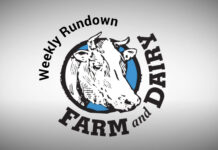By John Yost
Ohio State Extension
The current situation with Bovine Influenza A Virus/Highly Pathogenic Avian Influenza has brought to light potential deficiencies within our livestock and poultry production systems to deal with unforeseen challenges to animal health and the daily operation of our facilities. Hopefully, you have had been provided with information on developing a biosecurity plan for your operation.
While preventing the introduction and spread of animal disease is of upmost importance, you should also be asking yourself “What else am I not prepared for.” We know that emergencies can come in many forms. It could be something as simple as a power outage, or it could be as severe as a tornado. Regardless of the size and type of your farming operation, everyone should consider developing a whole farm emergency management plan to be ready for the unexpected.
Developing an emergency management plan will require careful thought but doesn’t have to be overly complicated. I equate them to Hazard Analysis Critical Control Point plans that are utilized by our food processing industry.
When developing a HACCP plan, you think of where a food safety problem can occur, implement control measures that will prevent it from happening and list the process for correcting the problem when it does happen. In this case, you are dealing with potential issues that you will not be able to prevent and, instead, create your action plan for when they do.
Contacts
A good place to start is by creating a contacts list. The name, position and phone number of every member of the management team should be on the list. You should also include contact information for your key service providers like veterinarians, feed, fuel, utility companies, milk truck drivers, etc; first responders, fire and law enforcement and anyone else you think should be informed if you have an emergency.
The physical address or emergency locator code should be included on this list. This list is one that you should copy and hang at key points around your facility for easy access by you and your employees.
Farm description
The second component is a detailed description of your operation and lists of your normal inventories. What structures do you have on the property and what is the name of each structure? What is stored or could be stored in those structures? How many, and what type of animal(s) could be housed in a building? Do you have fuel tanks? How many do you have, what do they store and what is their capacity? Do you have a well, are you on city water, is there a pond? You want to be as detailed as possible. This farm description should be accompanied by a labeled map. The map should show the location of every structure on your facility with the building name. Again, this is another area to try and include every detail possible.
Formulating a plan
Once you have your emergency contact list, farm description and map, you can then begin planning for all the things that can go wrong. I like to start with broad categories to focus my thoughts and then think of all the individual possibilities within those categories.
You can break this down however is easiest for you, but I group risks into: injuries to personnel, utility disruptions, natural disasters, animal health/foreign animal disease concerns and issues caused by the general public.
Once you have your comprehensive list, you again describe in as much detail as possible what your actions would be. For example, what should happen if you lose power. Your response plan could be as simple as: 1. The employee calls the facility manager, 2. The facility manager calls the power company to report the outage, 3. The employee that reported the outage checks that the generator kicked on. You should also plan for what happens if the generator doesn’t start. What will you do if it is going to be an extended outage?
Writing your plan will be time consuming, and your efforts shouldn’t conclude with a nice binder left to collect dust on an office shelf. You should read through the plan with all members of your farm team, whether that is an employee meeting or around the dinner table. You shouldn’t expect everyone to memorize every word of the document, but make sure they at least know who to call in case of an emergency. While we never want to experience any form of emergency on our farm, we should always be prepared for the unthinkable so we can react with forethought.
(John Yost is an educator in agriculture and natural resources at OSU Extension in Wayne County. He can be reached at yost.77@osu.edu.)













